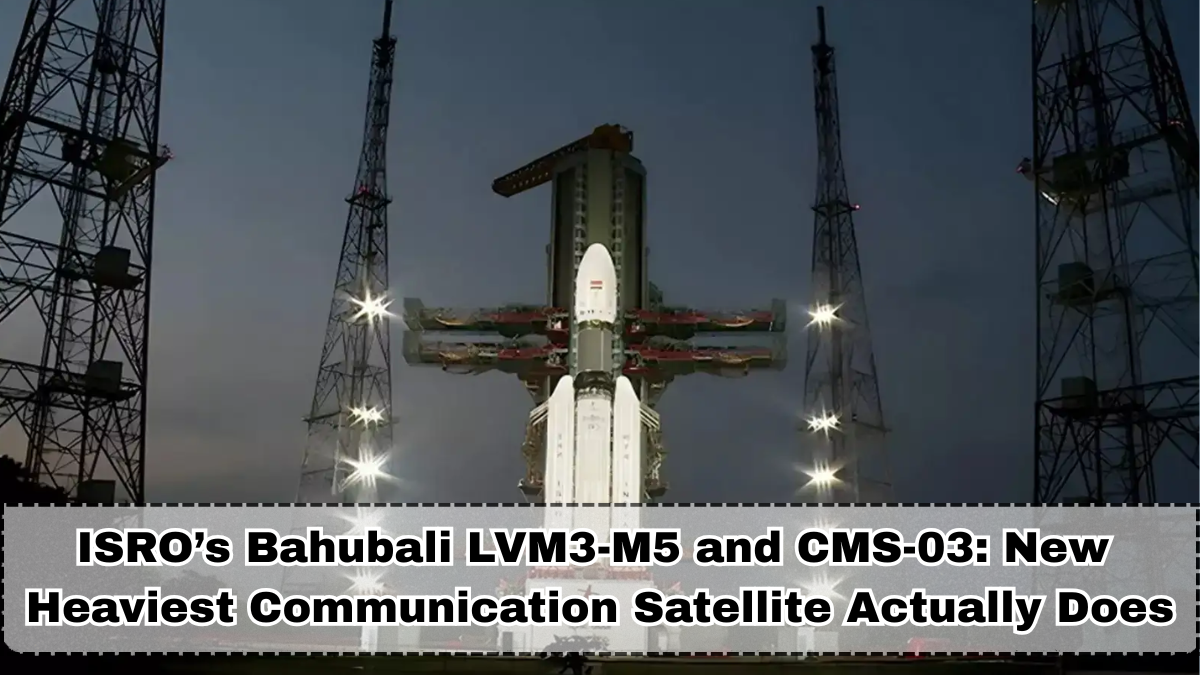India’s space programme achieved another major milestone with the ISRO CMS-03 LVM3 Bahubali mission explainer quickly becoming one of the most searched topics of the month. The LVM3-M5, famously called India’s “Bahubali” rocket for its massive lifting power, successfully launched the CMS-03 satellite—now recognised as one of the heaviest communication satellites India has ever deployed.
This mission strengthens India’s communication capabilities, especially for defence and maritime operations. CMS-03 is built to provide secure links, navigation support and real-time connectivity for the Indian Navy. With increasing tensions in the Indian Ocean, such satellites play a crucial role in strengthening surveillance and operational readiness.

What Exactly Is CMS-03?
CMS-03 is a powerful geostationary communication satellite weighing around 4,410 kg. It’s part of the GSAT series and is considered the advanced version of GSAT-7R. The satellite is designed to improve secure communication lines, especially between naval ships, submarines and command centres.
For the public, this satellite represents an important upgrade in India’s overall space communication infrastructure. The success of the ISRO CMS-03 LVM3 Bahubali mission explainer also shows the reliability of ISRO’s heavy-lift rockets.
Why the LVM3 Rocket Is Called “Bahubali”
The LVM3 is nicknamed Bahubali because it is ISRO’s most powerful rocket. It can carry heavy payloads into space and is used for some of India’s most important missions, including Chandrayaan-2 and commercial satellite launches. Its combination of solid boosters and cryogenic upper stage gives it the strength to lift satellites above 4 tonnes.
In this mission, the LVM3-M5 played a crucial role by placing the massive CMS-03 into its intended orbit accurately and safely.
What CMS-03 Will Do for India
Here’s a clear breakdown of the satellite’s purpose and benefits:
-
Boost secure communication for the Indian Navy
-
Improve maritime surveillance in the Indian Ocean
-
Strengthen communication between ships, aircraft and bases
-
Support network-centric warfare
-
Enhance disaster management communication capabilities
These capabilities significantly improve India’s defence preparedness.
Key Mission Highlights at a Glance
| Component | Details |
|---|---|
| Rocket | LVM3-M5 (“Bahubali”) |
| Payload | CMS-03 (Advanced GSAT-7R class satellite) |
| Weight | ~4,410 kg |
| Orbit | Geostationary |
| Purpose | Naval communication, secure links, surveillance |
| Result | Successful deployment |
This table gives a quick snapshot of why the mission is considered so important.
Why This Mission Matters for India’s Future
The ISRO CMS-03 LVM3 Bahubali mission explainer highlights a major leap in India’s space capabilities. With defence communication becoming critical, CMS-03 brings India closer to self-reliance in high-security satellite tech. It also strengthens India’s ability to monitor the Indian Ocean Region at a time when global competition in maritime zones is intensifying.
For ISRO, it further proves the reliability of the LVM3 rocket, opening doors for future heavier payloads and more international commercial contracts.
FAQs
What is the CMS-03 satellite used for?
It improves secure communication for the Indian Navy and strengthens maritime monitoring.
Why is LVM3 called Bahubali?
Because it’s ISRO’s most powerful rocket capable of lifting very heavy satellites.
How heavy is CMS-03?
It weighs about 4,410 kg, making it one of India’s heaviest communication satellites.
Does CMS-03 help civilians?
Indirectly yes—stronger communication networks improve overall national security and disaster connectivity.
Is this mission important for future launches?
Yes, it proves the LVM3’s ability to reliably carry heavy satellites and boosts confidence in future ISRO missions.
Click here to know more.
